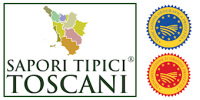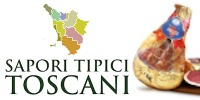Our network:
Sunday 22 December 2024
The Castles of Belcaro and Quattro Torri
Outside of Porta San Marco is the 12th century Castle of Belcaro, a building that has undergone a number of alterations over the centuries, the most important of which are by Baldassarre Peruzzi and Giuseppe Partini. Today the fortress is surrounded by grounds.
In 1525 the banker Crescenzo Turamini commissioned Baldassarre Peruzzi to draw up plans for a villa that was to stand over the ruins of the previously existing castle. Peruzzi was almost certainly also responsible for some of the fresco decorations within. When the castle-villa was captured by Cosimo de’ Medici in 1554 it was restored to its original function as a fortress. In the 19th century the building came into the hands of the Camaiori family, who had it restored in neo-Renaissance style by the architect Serafino Belli. In the second half of the 19th century Giuseppe Partini was commissioned to carry out further restorations, this time on the entrance portico and the perimeter walls.
Currently there are three open spaces composed of the gardens and two courtyards. The main entrance into the complex is through a large gate that leads into the first courtyard, triangular in shape. A second lower arch then leads into the internal courtyard, with the villa on the left and the servants quarters on the right. The villa itself is rectangular in shape, on three floors. The ground floor contains a number of arched entranceways.
Separated from the courtyard by an architectural backdrop in brick, with a central niche and round fountain flanked by two marble doorways with wrought iron gates, the garden is trapezoid in shape. Within the garden is the chapel and a frescoed loggia. A kitchen garden separates the garden from the secret garden laid out by Peruzzi.
The Castle of the Quattro Torri is at Santa Regina, in the outskirts of Siena. Its original structure, with the four towers that have given it its name, has remained unaltered since it was built between the 14th and 15th century. In 1376 the entire fortress passed into the hands of the Bichi family, who carried out improvements and restoration works into the mid-15th century.
The layout of the plan is square, in brick, with four angular towers of different sizes but all the same height. The entrance is through an acute archway. The interior courtyard is adorned on both sides by a portico, with a flight of steps leading to the upper floors. Toda the castle is still in private hands and is not open to the public.
In 1525 the banker Crescenzo Turamini commissioned Baldassarre Peruzzi to draw up plans for a villa that was to stand over the ruins of the previously existing castle. Peruzzi was almost certainly also responsible for some of the fresco decorations within. When the castle-villa was captured by Cosimo de’ Medici in 1554 it was restored to its original function as a fortress. In the 19th century the building came into the hands of the Camaiori family, who had it restored in neo-Renaissance style by the architect Serafino Belli. In the second half of the 19th century Giuseppe Partini was commissioned to carry out further restorations, this time on the entrance portico and the perimeter walls.
Currently there are three open spaces composed of the gardens and two courtyards. The main entrance into the complex is through a large gate that leads into the first courtyard, triangular in shape. A second lower arch then leads into the internal courtyard, with the villa on the left and the servants quarters on the right. The villa itself is rectangular in shape, on three floors. The ground floor contains a number of arched entranceways.
Separated from the courtyard by an architectural backdrop in brick, with a central niche and round fountain flanked by two marble doorways with wrought iron gates, the garden is trapezoid in shape. Within the garden is the chapel and a frescoed loggia. A kitchen garden separates the garden from the secret garden laid out by Peruzzi.
The Castle of the Quattro Torri is at Santa Regina, in the outskirts of Siena. Its original structure, with the four towers that have given it its name, has remained unaltered since it was built between the 14th and 15th century. In 1376 the entire fortress passed into the hands of the Bichi family, who carried out improvements and restoration works into the mid-15th century.
The layout of the plan is square, in brick, with four angular towers of different sizes but all the same height. The entrance is through an acute archway. The interior courtyard is adorned on both sides by a portico, with a flight of steps leading to the upper floors. Toda the castle is still in private hands and is not open to the public.
Booking.com
• Siena in the Renaissance
• Siena in the Middle Ages
• Siena in Antiquity
• Town Map Siena
• Farm Holidays and Country Houses
• Residence, Apartments
• Bed & Breakfasts
• Historical Residences
• Last Minute Siena
• Restaurants
• Pubs & Wine Bar
• University for Foreigners
• Palazzo Chigi-Saracini
• Palazzo d’Elci degli Alessi
• Loggia della Mercanzia
• Palazzo Sansedoni
• Palazzo Chigi-Zondadari
• Fonte Gaia fountain
• Carthusian Monastery of Pontignano
• Forte di Santa Barbara
• The Duomo – The Cathedral of the Assunta
• Church of the Osservanza
• The Oratory of San Bernardino
• Church of San Francesco
• Short Biography of St Catherine of Siena
• St Catherine Sanctuary
• Church of S. Niccolò al Carmine
• Bologna-Buonsignori museum
• Accademia dei Fisiocritici
• I Musei Senesi
• The Palazzo Pubblico and the Torre del Mangia
• Piazza del Campo
• The Montagnola Senese and the Fortified Village of Sovicille
• The Castles of Belcaro and Quattro Torri
General information
• Town map • Siena in the Renaissance
• Siena in the Middle Ages
• Siena in Antiquity
Transport in town
• Map of Hotels in Siena • Town Map Siena
Transport out of town
• Train services
Where to Stay
• Hotels • Farm Holidays and Country Houses
• Residence, Apartments
• Bed & Breakfasts
• Historical Residences
OFFERS & LAST MINUTE
• Reservation Services Siena • Last Minute Siena
Where to eat and drink
• Disco Dancing • Restaurants
• Pubs & Wine Bar
Education
• Siena University • University for Foreigners
Art and monuments
• Palazzo Piccolomini and Palazzo delle Papesse • Palazzo Chigi-Saracini
• Palazzo d’Elci degli Alessi
• Loggia della Mercanzia
• Palazzo Sansedoni
• Palazzo Chigi-Zondadari
• Fonte Gaia fountain
• Carthusian Monastery of Pontignano
• Forte di Santa Barbara
Art and religion
• Church of Sant’Agostino • The Duomo – The Cathedral of the Assunta
• Church of the Osservanza
• The Oratory of San Bernardino
• Church of San Francesco
• Short Biography of St Catherine of Siena
• St Catherine Sanctuary
• Church of S. Niccolò al Carmine
Museums and galleries
• The Museo Civico • Bologna-Buonsignori museum
• Accademia dei Fisiocritici
• I Musei Senesi
Art and tourist attractions
• Cappella di Piazza • The Palazzo Pubblico and the Torre del Mangia
• Piazza del Campo
• The Montagnola Senese and the Fortified Village of Sovicille
• The Castles of Belcaro and Quattro Torri
Booking.com
• The July and August Palio
• The Contrade
• The Days of the Palio
• The Drappellone
• The Eve of the Palio
• The Corteo Storico Procession
• The Race
• The Patron Saint and Oratory of Each Contrada
• Weekly Appointments in each Contrada from April onwards
• Croce del Travaglio Place
• From Piazza del Campo to the Duomo Along Via di Città
• The Curves of Piazza del Campo
• Costarella dei Barbieri street
• Borgo d’Ovile
• The Terzo of Camollia – main streets
• Casato di Sopra e Casato di Sotto
• Terzo di San Martino district
• The Terzo di Città District - Via Stalloreggi, Via San Quirico
• The Terzo di Città District – The Pinacoteca Nazionale
• Golf courses in Siena and Tuscany
• Wedding in Tuscany - Siena area
• San Casciano dei Bagni
• Chianciano Terme
• Bagni San Filippo
• Bagno Vignoni
• Rapolano Terme - Baths of San Giovanni and Baths of the Antica Querciolaia
• The Countryside around Siena and its Thermal Water Springs
• SkiPass Monte Amiata
• WebCam sul Monte Amiata
• Meteo Monte Amiata
• The Val d’Orcia and Its Main Towns
• Pienza - the old town centre
• Montepulciano - the old town centre
• San Quirico d’Orcia - the old town centre
• Montalcino and the Land of Brunello
• The Abbey of Monte Oliveto Maggiore and the Crete
• The Crete Senesi
• Castellina in Chianti and the Via Chiantigiana Towards Siena
• Siena and Southern Chianti - from the Castle of Montalto to the Castle of Brolio and on to the Castle of Meleto
• The Chianti Hills - Monte Calvo, Monte Luco and Monte San Michele
• Cortona and the Valdichiana
• San Gimignano - The old town centre and its major sights
• The Val d’Elsa - Monteriggioni and Colle di Val d’Elsa
• Along the Old Via Francigena
• Oleum Evo online selling
• Sapori Tipici Italiani buy online now
• il Prosciutto Cotto
The Palio of Siena
• The Origins • The July and August Palio
• The Contrade
• The Days of the Palio
• The Drappellone
• The Eve of the Palio
• The Corteo Storico Procession
• The Race
• The Patron Saint and Oratory of Each Contrada
• Weekly Appointments in each Contrada from April onwards
Sightseeing
• Via di Città (formerly Via Galgaria), Siena’s Most Elegant Street • Croce del Travaglio Place
• From Piazza del Campo to the Duomo Along Via di Città
• The Curves of Piazza del Campo
• Costarella dei Barbieri street
• Borgo d’Ovile
• The Terzo of Camollia – main streets
• Casato di Sopra e Casato di Sotto
• Terzo di San Martino district
• The Terzo di Città District - Via Stalloreggi, Via San Quirico
• The Terzo di Città District – The Pinacoteca Nazionale
What to see & do
• Wedding in Siena • Golf courses in Siena and Tuscany
• Wedding in Tuscany - Siena area
• San Casciano dei Bagni
• Chianciano Terme
• Bagni San Filippo
• Bagno Vignoni
• Rapolano Terme - Baths of San Giovanni and Baths of the Antica Querciolaia
• The Countryside around Siena and its Thermal Water Springs
Monte Amiata
• Monte Amiata - nature tourism the year round • SkiPass Monte Amiata
• WebCam sul Monte Amiata
• Meteo Monte Amiata
Specials - Out of town
• Gift Ideas for traveling • The Val d’Orcia and Its Main Towns
• Pienza - the old town centre
• Montepulciano - the old town centre
• San Quirico d’Orcia - the old town centre
• Montalcino and the Land of Brunello
• The Abbey of Monte Oliveto Maggiore and the Crete
• The Crete Senesi
• Castellina in Chianti and the Via Chiantigiana Towards Siena
• Siena and Southern Chianti - from the Castle of Montalto to the Castle of Brolio and on to the Castle of Meleto
• The Chianti Hills - Monte Calvo, Monte Luco and Monte San Michele
• Cortona and the Valdichiana
• San Gimignano - The old town centre and its major sights
• The Val d’Elsa - Monteriggioni and Colle di Val d’Elsa
• Along the Old Via Francigena
Typical products
• Typical Tuscan flavours • Oleum Evo online selling
• Sapori Tipici Italiani buy online now
• il Prosciutto Cotto









